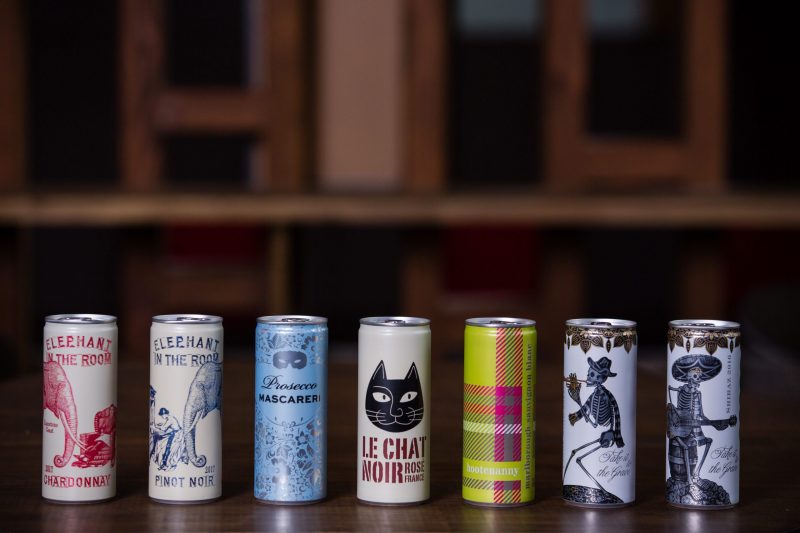Consumer demand for environmentally sustainable wine packaging, coupled with a preference for simple convenience, has led to the recent growth in the number of Australian winemakers producing wine in a can.
Journalist Samuel Squire spoke to those involved in the production of canned wine to learn about the winemaking process and how this differs from making bottled wine.
Research from the Australian Wine Research Institute (AWRI) shows that the ‘wine in a can’ format has been a fast growing product category internationally, with segments of the US market leading the way.
Australian company Barokes Wines has been at the forefront of developing the processes to can wine and it patented its innovative Vinsafe technology back in 2001. It has since leased the technology to a number of wine companies that utilise it to can their wine.
Based in Melbourne, Barokes Wines say its Vinsafe technology is an integrated system which incorporates the wine, can and filling technique, which work together to produce consistent, quality wine products in can format.
According to sales and marketing director Irene Stokes, “Barokes are the creators and owners of the Vinsafe wine packaging system, which safely allows the sealing of wine in a can to achieve product integrity, stability and longevity of up to five years post-canning”.
She added that Vinsafe was developed for canned wine to last and that other versions of the technology to date haven’t been as successful.
But with the technology available to winemakers to safely seal wine in cans without compromising product quality, what of the winemaking process itself?
AWRI research states that commercial wines in cans often display reductive characters, like unpleasant aromatics, for example.
“The wine making process is fundamentally the same,” revealed Stokes. “However, there are specific key wine analytical parameters — to Vinsafe Specifications — and vinification processes that must be adhered to in order for the wine to be able to achieve more than three months shelf life in the can.
“The Vinsafe technology ensures an exact equilibrium between the wine, headspace, lining and can is achieved and [this] allows the expansion and contraction under heat or cold of these four interrelating aspects at exactly the same rate to ensure wine and product stability, consistency, and shelf life whilst also maintaining the wines’ integrity/quality, as produced by the winemaker.
“In effect, we had to reverse engineer the traditional approach to the winemaking process by considering the can and lining as the first thing to be considered, given its constant potential to react with the wine. [This is] followed by the filling specification and then by the wine parameters, rather than the traditional method of making the wine and it [not] matter[ing] what container it went into.”
The difference between wine made for cans and for bottles
Stokes said that the overall process for making wine for canning is not all that different to making wine for bottles, but added there is one stark difference between the two.
“What differs between canned wine and wine made for bottling is that whilst you can bottle wine made for cans, you cannot can wine made for bottling,” she said.
“Winemaking for cans is generally a harder process because winemakers now have to consider the constant interactive nature of the packaging (aluminium can) that the winemaker has not had to consider in the past.
“What this means is that wine reacts to aluminium in very different ways than it does to glass and keeping that in mind during the winemaking process is difficult.”
Winemaker Corey Ryan, from Newcastle-based wine producer and wholesaler Fourth Wave Wine, agreed that the ways in which wine is produced for cans and bottles aren’t drastically different.
In fact, he added that much of the process is quite similar and only requires a minimal amount of tweaking.
“For us, the winemaking is virtually the same, it differs when it comes to packaging, and not just what it’s packaged in,” he said.
“When we can our wines, we tend to add small quantities of nitrogen gas because you need more pressure in the can once it’s closed.
“The result of that is a slight crisp sensation when the wine is tasted, it does not affect the flavour of the wine at all.”
Ryan said the movement of wineries toward making wine for cans is part of a broader shift within the Australian wine industry to appeal to a younger, more environmentally-conscious market.
However, he said that the move to canned wine over the last few years hasn’t been driven by whether or not cans are better than other wine containers like bottles, but rather, it has been prompted by the convenience offered by cans to the consumer.
“With the way wine is consumed these days, people look for different, more sustainable and less restrictive means for drinking wine,” he added.
“Cans used for wine typically hold a volume of 250ml, which is a lot easier for some wine consumers to justify drinking if they don’t want to open and drink an entire bottle.
A ‘longer shelf life’ for consumers?
“That also means canned wine could have a longer shelf life than bottled wine because a consumer might not want to drink an entire bottle in a day or couple of days. In a bottle, after the fourth or fifth day, wine isn’t as fresh. But because cans break up a whole bottle into segments, wine lasts longer.”
Ryan continued that wine in a can has only really taken off in the last couple of years due to this consumer demand for convenience over the time-gated pressure of finishing a bottle before it loses its freshness.
Irene Stokes explained that canned wine isn’t only affected by the approach taken during the winemaking process, but also by the materials used in the container.
She mentioned that while the wine is only tweaked to a small degree during winemaking, the effect that the cans themselves can have on the wine needs to be taken into consideration also.
“There can be differences in wine flavours if the winery isn’t using a system that takes into account the effects that the cans and can linings have on the wine itself, by using specific wine parameters, filling specifications and the can and lining specifications, as many people coming to us for the solution have now experienced,” she added.
“As has been found by these winemakers and fillers, the can maker simply increasing the can lining thickness is not the solution to dissipating wine flavour difference and, in fact, creates further problems for wine and lining integration, H2S, pin holing and aluminium uptake into the wine, leading to very short, unstable shelf lives and consumer safety concerns.”
Despite such concerns, Stokes believes that the trend of more Australian winemakers embracing the format and producing wine in a can is set to enter a boom period, as long as canning procedures are carried out properly.
“We (Barokes) have pioneered this wine category globally and taken it from a track to a road,” she said.
“Now with other wine labels licensing the Vinsafe solution from us, it will become a highway, then soon after a super freeway for wine in a can and its sustainability globally.
“The level of interest that [Barokes] is currently receiving from wineries and fillers wanting to enter the wine in a can category through Vinsafe has increased significantly in the past 12 months and that, coupled with consumer demand for safe, reliable and consistent wine in a can and retailer interest, will ensure the growth of the wine in a can category in Australia.
This article was originally published in the February issue of The Australian & New Zealand Grapegrower & Winemaker. To find out more about our monthly magazine, or to subscribe, click here!
















